National Reconciliation Week 2019
May 26, 2019Grounded in Truth: Walking Together With Courage.
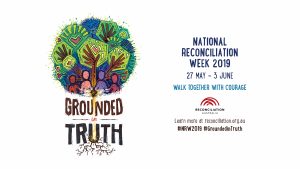 Australian Story recently featured the famous and very popular folk/pop quartet “The Seekers”. Listening to their story and particularly the story of their breakup and ongoing relationships, gave me some insight into what might be involved in creatively living into or engaging with this year’s theme for National Reconciliation Week –Grounded in Truth Walk Together With Courage.
Australian Story recently featured the famous and very popular folk/pop quartet “The Seekers”. Listening to their story and particularly the story of their breakup and ongoing relationships, gave me some insight into what might be involved in creatively living into or engaging with this year’s theme for National Reconciliation Week –Grounded in Truth Walk Together With Courage.
The Seekers formed in Melbourne in 1962 and in 1964 travelled to the UK on the Fairsky as “on board” entertainment. Once in the UK they became very popular and were signed up by EMI Records. However Judith Durham by her own admission was a perfectionist and sometimes felt artistically on another page to the three men. In 1968 after an incident on stage in New Zealand she decided to act on her growing desire to go solo, which spelt the end for the Seekers. For Bruce Woodley this caused an end to many of his aspirations, and just when they were being offered a new record deal.
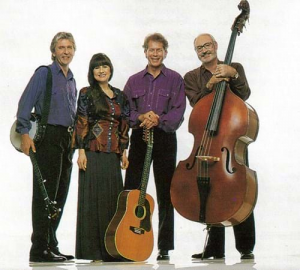
Years later Bruce wrote to Judith because he felt uneasy in his heart, about the resentment towards her, that he was carrying. He wanted her to know how hurt he was by the breakup and how it affected him. Judith could not believe what she was reading. She had no idea of Bruce’s feelings, as for her, she had given them all notice of her plans, she thought they were all okay with them. In 1990 after Judith’s car accident the group rallied around her. When Bruce and Judith met, Judith apologised to Bruce and said sorry for the hurt she had caused him. Bruce was impressed by her bravery in saying sorry and for him he could finally let go of his resentment and hurt.
The story of Bruce and Judith’s reconciliation highlights the central role of “truth telling” in healing and reconciliation.

The Reconciliation Barometer, a biannual survey undertaken in Australia which measures the progress of reconciliation between Aboriginal and Torres Strait Islander people and non-Indigenous Australians, indicates that 80% of the general community and 91% of Aboriginal and Torres Strait Islander peoples widely believe it’s important to undertake a formal truth telling process, in relation to Australia’s shared history.
Many stories of the Australian frontier have been hidden or denied. In telling some of these stories during March of 2019 The Guardian series, The Killing Times, counts the human cost of more than a century of frontier bloodshed and asks, are we ready for truth telling?
Dr. Paula Green the director of the Karuna Centre for Peacebuilding in the USA refers to Reconciliation as a “A Path of Courage, Commitment and Compassion. It was this for Bruce Woodley and Judith Durham. What can it be for us?
During NRW, let us also be inspired to ‘walk together with courage’ as we contribute to building stronger relationships based on truth telling. You might:
- read an article from the online Guardian series mentioned above
- visit the digital map of the sites of the Frontier Wars created by The University of Newcastle’s Professor Lyndall Ryan
- create a time when the community can gather to pray the Sorry and Reconciliation Prayer from Vol 1 Pg 48 Josephite Prayer Bk or Pg 44 of Act Love and Walk
Marianne Zeinstra rsj
Visit the ‘Reconciliation Australia’ website
Images:
National Reconciliation Week image sourced from their website.
Photo of The Seekers sourced from their website.
Reconciliation Barometer sourced from a 2010 Public Document from their website.
Melbourne’s Second Providence Immortalised in Glass
May 24, 2019Here in Melbourne, Australia’s most liveable city, we had the official unveiling of the graphics on the exterior of the Department of Lands Water, Environment and Parks Building on Wednesday 13 March at 11.00am in the buildings newly refurbished people’s foyer.
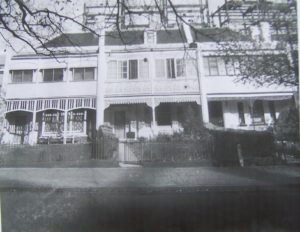
The official unveiling of the graphic of the second Providence of the Sisters of Saint Joseph in Melbourne and a corresponding graphic with an explanatory text, was hosted by Kathryn Anderson, Deputy Secretary of the Department of Environment, Water, Land and Planning. The staff supported by the building’s owners, “Dexus,” were responsible for the graphic design and its installation on the corner of Nicholson Street and Victoria Parade, one of Melbourne’s busiest intersections. Kathryn spoke very movingly of Mary MacKillop’s life and in particular the work of Mary and her Sisters of Saint Joseph in this very poor and depraved area of Melbourne in the 1890s.
Sr Kerrie Cusack, Regional Leader of the Sisters of Saint Joseph in Victoria-Tasmania, spoke of her delight in seeing the work of Mary and the Sisters of Saint Joseph being acknowledged as part of the history of this area of Melbourne, so close to where Mary established the first providence together with a day school for the poor and needy children and a night school for young servant girls and factory workers. Sr Helen Smith spoke beautifully of a couple of ‘lively’ stories of occurrences recorded in Mary’s own letters or in correspondence to Mary from her Sisters.
Garry McLean, CEO of the Mary MacKillop Heritage Centre thanked Kathryn and members of her department including Kelly Crosthwaite, Angelo Guastella and the Infrastructure Services Team.
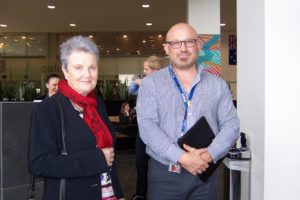
The five metre graphics face Victoria Parade. There is a photograph of the original building where the second providence was established by Mary and the Sisters of Saint Joseph in 1892. The second five metre graphic provides a written synopsis of the work of Mary and the Sisters of Saint Joseph in this area of a fledgling Melbourne in the 1890s. It also recalls the other two Providences and the final permanent St Joseph’s Providence established at 362 Albert Street East Melbourne, which is now the Mary MacKillop Heritage Centre.
The windows project transpired through a chance meeting at a function between Kelly Crosthwaithe and Patricia Williams rsj. Patricia explained to Kelly that where she worked was “Sacred Ground” because it was the site of Mary MacKillop’s Providence No. 2. Patricia suggested that it would be good if the spot could be marked. Kelly took up the idea and persisted with it till we have what we see here today.
Garry McLean
CEO Mary MacKillop Heritage Centre, East Melbourne
Photos courtesy of Mary MacKillop Heritage Centre Staff. Used with permission.
First Tasmanian Foundation, Westbury 1887
24 May – a significant day for Sisters of Saint Joseph in Tasmania
May 24 has been a significant date in Catholic history since 1815 when Pope Pius VII declared it to be the feast day of Our Lady Help of Christians—marking the date of his release from imprisonment by Napoleon during the French occupation of Rome in 1814.
In 1844 the bishops attending the first provincial synod of the Church in Australia decided that it be placed under the patronage of Mary, Help of Christians. This happened at a significant time in our history. British settlement was just over fifty years old, the transportation of convicts was coming to an end, and the first elections in Australian history had been held in the previous year. Issues of land, immigration and education had begun to surface and the Church was becoming involved with these social problems.
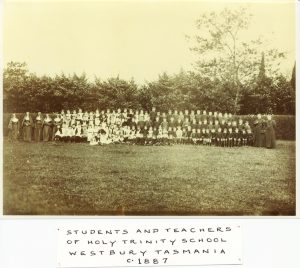 The infant church in Australia had a special reason for turning to Mary. The British Government had forbidden priests to come to the colony at the time of settlement in 1788. The first Catholic priests, who arrived as convicts in 1800, had been convicted for “complicity” in the Irish 1798 Rebellion. One of their number was conditionally emancipated and permitted to celebrate Mass under strict conditions for about one year only. The first resident priests, John Joseph Therry and Philip Connolly, arrived in 1820. During those long years of deprivation of Mass and the sacraments, it was largely the Rosary that kept the faith alive.
The infant church in Australia had a special reason for turning to Mary. The British Government had forbidden priests to come to the colony at the time of settlement in 1788. The first Catholic priests, who arrived as convicts in 1800, had been convicted for “complicity” in the Irish 1798 Rebellion. One of their number was conditionally emancipated and permitted to celebrate Mass under strict conditions for about one year only. The first resident priests, John Joseph Therry and Philip Connolly, arrived in 1820. During those long years of deprivation of Mass and the sacraments, it was largely the Rosary that kept the faith alive.
For the Sisters of Saint Joseph in Tasmania, 24 May has an extra significance. It was on this day in 1887 that Sisters Francis McCarthy, Stanislaus Doyle, Joseph Eather, Patrick Nolan and Teresa Prendergast arrived in Westbury. They had travelled from Perthville (Bathurst) to Sydney by train and then by ship to Launceston before arriving at their final destination – without doubt a long and often uncomfortable journey.
Sister Francis who was 37 years old had come to Australia from Ireland to enter the Sisters of Saint Joseph in Bathurst 13 years earlier. Sister Stanislaus was 25 and had come from County Wexford to Bathurst as a young child with her family. She had been a Sister of Saint Joseph for five years. Sister Joseph, from Newcastle, NSW, was aged 27 and had been finally professed as a Sister of Saint Joseph only two weeks before she left for Tasmania. She had been known as Sister Mary Bernard for the previous eight years but changed her name to Sister Joseph so that the tradition of having a Sister Joseph in each new group could be maintained.[i] Sister Patrick, from Kerry, Ireland, was aged 60 and had been a Sister of Saint Joseph for only 12 years. Sister Teresa, possibly a niece of Sister Stanislaus, aged 21, was from Victoria and had been a Sister of Saint Joseph for four years.[ii]
Continue reading Carmel’s article below:
First Tasmanian Foundation, Westbury 1887 (PDF)
Carmel Jones rsj
Visit the Sisters of Saint Joseph Tasmanian history page here:
[i] Sisters from Bathurst had previously been sent to make foundations at Wanganui, New Zealand 1880, Goulburn, NSW 1882, Lochinvar, NSW 1883.)
[ii] Reference: Josephine Brady, St Joseph’s Island, ATF, 2012 pp 17-27.
[iii] Julian E.T. Woods, Rules of the Institute of St Joseph for the Catholic Education of Poor Children, Adelaide, 1867, Article 4.. It is interesting to note that in the Customs and Practices of the Institute of The Sisters of St Joseph of the Sacred Heart of The Archdiocese of Hobart, Melbourne, 1940, “as much recreation as is convenient is allowed”
[iv] After Angelus a prayer for the conversion of Australia invoking the intercession of Mary, Help of Christians, was part of the Sisters’ daily routine.
[v] Letter JET Woods to Sister Francis McCarthy, August 1887.
[vi] ‘Westbury Diary’, in Sisters of St Joseph Archives, New Town Tasmania, 1887.
[vii] The Monitor 29 May 1908
Photo from the Sisters of Saint Joseph archives in New Town, Tasmania. Used with permission.
National Volunteer Week 2019
May 20, 2019National Volunteer Week is held from 20 until 26 May 2019.
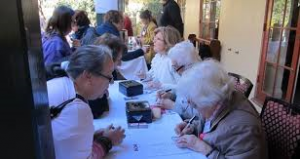 I wish to dedicate this article to all those who so generously volunteer at Mary MacKillop Place in North Sydney.
I wish to dedicate this article to all those who so generously volunteer at Mary MacKillop Place in North Sydney.
Many people come daily to Mary MacKillop Place as pilgrims to sit quietly in the chapel and to visit Mary’s tomb. Many share the hospitality of the Café and Shop as well as Tour the Museum.
Without the women and men who come here each day to volunteer in the various places where help is always needed, we would be unable to do the work that is required for our Pilgrims.
Each Volunteer has to be initiated into the Department in which they wish to work. This requires an Interview with the Volunteer Co-ordinator and the Department Manager who will take them through what is required. All Volunteers must have a Working With Children Check Number.
Our volunteers are found in the:
Chapel: i) The Pastoral Carers sit at the back of the chapel and are available for those who wish to speak with them. We have 25 volunteers who are rostered weekly, fortnightly or monthly and ii) We have a number of volunteers who keep the Chapel, Tomb Area and reflection Room clean and tidy.
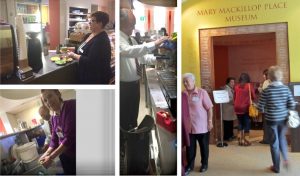 Café/Shop: is where the greater number of volunteers help out. We depend on their generosity to welcome and serve those who come in each day. Some days are busier than others, such as Wednesdays, the 8th of the Month and each Sunday after Mass.
Café/Shop: is where the greater number of volunteers help out. We depend on their generosity to welcome and serve those who come in each day. Some days are busier than others, such as Wednesdays, the 8th of the Month and each Sunday after Mass.
Museum: Each year we have a number of schools, Parish Groups, Probus Clubs and Senior Groups who book in regularly. Our dedicated Guides take them through the Museum sharing the Story of Mary MacKillop and showing them hospitality. Our Guides are trained and keep up to date with the many changes that occur during the year in the Museum. Volunteers also work with the Curator and Archivist.
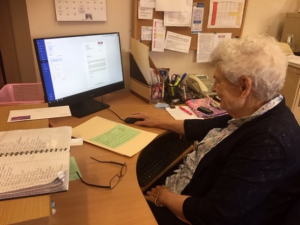 Pastoral Care Office: This is where a lot of behind the scenes work takes place often generated by those who work in the Chapel. The answering of prayer requests by ‘phone is a very privileged role. The Recording of Novenas, typing prayer lists to put beside Mary’s tomb, replacing necessary supplies in the Chapel are just some of the roles required. Many of our Volunteers are kept busy by helping the Pastoral Care Staff do those jobs which require many hands. Our volunteers are generous, cheerful, loyal and greatly appreciated by the Sisters of Saint Joseph whom they serve.
Pastoral Care Office: This is where a lot of behind the scenes work takes place often generated by those who work in the Chapel. The answering of prayer requests by ‘phone is a very privileged role. The Recording of Novenas, typing prayer lists to put beside Mary’s tomb, replacing necessary supplies in the Chapel are just some of the roles required. Many of our Volunteers are kept busy by helping the Pastoral Care Staff do those jobs which require many hands. Our volunteers are generous, cheerful, loyal and greatly appreciated by the Sisters of Saint Joseph whom they serve.
On Mary MacKillop’s Feast Day on 8 August, all volunteers regardless of which days they normally attend are on hand to help out. This is a great witness of the work of our Volunteers who work here at Mary MacKillop Place throughout the year.
Marie McAlister rsj
Find out more about volunteering at Mary MacKillop Place
Visit the National Volunteer Week website
Photos provided by Sr Marie McAlister. Used with permission.
International Day of Families
May 15, 2019The International Day of Families is held on 15 May every year.
The day was proclaimed in 1993 by the United Nations General Assembly and reflects the importance the international community attaches to families, enabling time to celebrate the importance and role of families in society.
Although families all over the world have transformed greatly over the past decades in terms of their structure, the United Nations still recognises the family as the basic unit of society. The Day also provides an opportunity to promote awareness of issues relating to families.
This year, Good Grief have provided an resource titled “Children and Change and Loss”:
 When a child is grieving it is natural to want to support them. Yet, we often feel very uncertain about how best to do so. Perhaps you feel uncomfortable about discussing loss and grief, worried whether your child’s behaviour is normal, and unsure what you can do to help. This fact sheet offers some guidance for adults (parents, carers, relatives, teachers and others) to help you support a child who is grieving and nurture them to grow through the experience.
When a child is grieving it is natural to want to support them. Yet, we often feel very uncertain about how best to do so. Perhaps you feel uncomfortable about discussing loss and grief, worried whether your child’s behaviour is normal, and unsure what you can do to help. This fact sheet offers some guidance for adults (parents, carers, relatives, teachers and others) to help you support a child who is grieving and nurture them to grow through the experience.
What is grief?
Grief is the human response to change and loss in our lives, such as the death of someone we love, parental separation or other major change. It is a natural and normal response, which has a physical impact on our bodies as well affecting our emotions and our thinking. Grief challenges the way we think about ourselves and the world, and influences our spirituality and relationships.
How do children express grief?
Like adults, children express grief in unique and personal ways. This can be influenced by a child’s age and understanding of the loss, but also by other factors such as their character, situation or experience. Some children may openly express their hurt, while others may withdraw. Many children also dip in and out of grief, alternating between grieving and more playful behaviour. It is important to remember that grief is a normal and natural response and that there is no right or wrong way to grieve. Some (not an exhaustive list) of the reactions children may experience…
Please continue reading below:
First steps towards the Foundation of the Order
May 11, 2019Father Julian Tenison Woods: First steps towards foundation—little did they then dream
On 19 March 1866, Julian Woods and Mary MacKillop took their first tentative steps towards the foundation of the Institute [1] of Saint Joseph. Mary, who had charge of the catholic school in Penola, indicated her commitment by wearing a black dress. Years later she described it to the Sisters thus:
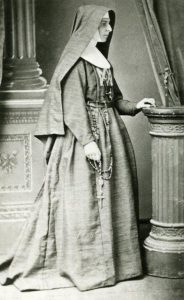
Within six months the way had become significantly clearer. In August 1866, Julian attended Bishop Sheil’s episcopal consecration in Melbourne. Soon afterwards he informed Mary: “I am appointed Director General of Catholic Education, Chairman of the Board and Inspector of Schools throughout the diocese.” [3]
He could scarcely contain his delight for now he was to have sole control of Catholic Education in the diocese and thus, had received, suddenly and completely, the means of establishing the religious for poor schools. [4] In his excitement the words tumbled from his pen and, although he was sad at having to leave Penola, the future held much promise.
Then, on 21 November 1866, Blanche Amsinck, a governess from Western Victoria, became the second woman to commit herself to becoming a Sister of Saint Joseph. Just after the New Year, she wrote to Mary:
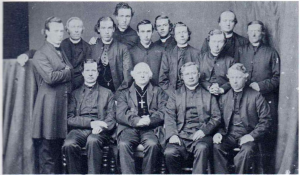
Woods, who had moved to Adelaide in April 1867, soon realised that he needed Mary’s expert help in managing the schools. Then he faced a dilemma! As he announced that the Sisters of Saint Joseph were coming he realised that his Sisters, by this time all three of them, were not wearing an easily recognisable religious habit and did not have a written rule of life. [7]
Wisely, he left the decision regarding the sisters’ dress to these women, but he took full responsibility for drawing up their Rule of Life. According to his Memoirs, “it was written by him in a couple of days in May 1867. [8]
He then sent it to his three Sisters, instructing them to copy it out in full and send him their copy. His reason—some of the clergy were throwing “deluges of cold water” on his idea and he did not wish to draw their attention to the fact the he was the one who had written this Rule. [9]
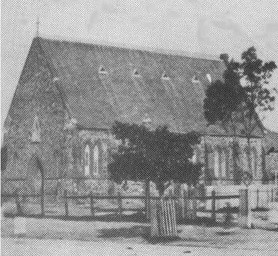
In late June, Mary and Rose arrived in Adelaide and undertook the management of the local Cathedral school. Parents were delighted and enrolment increased dramatically. Thanks to Woods’ enthusiasm, more young women joined the Institute. By the end of 1867, it had ten members teaching in three schools and managing a Refuge for women recently released from gaol. The future looked promising indeed!
On 17 December 1868, when the Institute had fifty members teaching in nine schools and managing three charitable institutions— a Refuge, an Orphanage and a House of Providence— Bishop Sheil approved Woods’ Rule for use in his diocese and agreed for it to be printed. Matters were moving much more quickly than any of them had ever dreamed.
Sr Marie Foale
Footnotes:
[1] The word Institute is used in this article because, during those foundation years of the Congregation of the Sisters of Saint Joseph it was, in fact, known as an Institute. The word Congregation was not used until many years later.
[2] Mary to the Sisters on the Silver Jubilee of the Congregation, 4 March 1893.
[3] Julian to Mary, 19 September 1866, Mary & Julian, Their Letters, 1862-1868, Trustees of the Sisters of Saint Joseph of the Sacred Heart, 1989.
[4] Julian to Mary, 19 September 1866.
[5] Blanche Amsinck to Mary from Mount Gambier, 3 January 1867.
[6] Mary to Julian, 2 February 1867.
[7] Their third member was Rose Cunningham who donned the black dress on 3 May 1867.
[8] Woods Memoirs, typescript copy without page numbers. One can only wonder how he managed to produce, by hand, a document of more than 7,000 words in a couple of days.
[9] Julian to Mary, 23 August 1866.
[10] Standing: L to R: Fathers Christopher Reynolds, Peter Hughes, Julian Woods, Michael O’Connor, Thomas Dowling, Theodore Bongaerts, Charles Van Der Heyden; Frederick Byrne, Simon Carew, Alois Kranewittcr SJ. Seated. John Smyth V.G., Bishop Lawrence Sheil, Josef Tappeiner SJ, Patrick Russell. Eight plus the bishop were Irish, five, including Julian Woods, were not.
Images provided by Sr Marie Foale. Used with permission.
A Day in the Life: Prison Ministry
May 8, 2019This month you’re invited to read about Sr Liz’s Prison Chaplaincy.
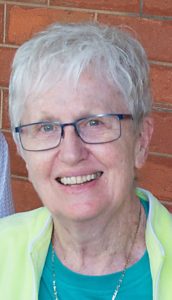
On passing through security with personal, and clear plastic bag scanning complete, one collects her keys, duress alarm, and signs in. It’s then out into the prison proper not knowing what the day may hold regarding the residents nor the situations that may have occurred prior to the day.
For me it’s coming into a space where I meet Jesus, broken and poor, walking the Via Dolorosa on the way to judgement day. I see the role of chaplain as being that of Simon helping to carry the cross, trying to lessen the load.
Each visit I make is unique to that resident where in listening to him I offer whatever support I can. Its like I am tending the soil, to allow more nourishment for the plant, the resident. Our support is about helping the person to try to feel a sense of hope for his future. I believe it’s important to help him understand that whatever has brought him to this place in his life, does not define who he is, but is a part of him. No person is free from making mistakes, but the important thing is to learn from them.
As a chaplain I attempt to help the resident identify where life started to go off the rails and to encourage them to seek help in working through those issues. It’s about helping to build or rebuild their self-esteem and self-confidence, encouraging them to believe they can achieve what they desire in life. Discussions around choices, not only on life matters, but also friendship groups and sometimes family are challenges they often mention, along with the ‘band aid’ solutions they seek through alcohol and drugs; either, or both.
I find this ministry to be very grounding, as I listen to the resident’s stories and realize what is shared could be so for any person, given the right circumstances and the right buttons pushed. It can be challenging and at times frustrating but it’s not about me it’s about those on the inside.
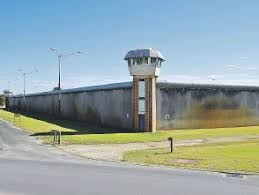
Working with the staff in a respectful manner has brought respect in return. I believe the prison values our services and sees us as part of the prison team. We have a regular meeting with the Assistant Superintendent Offender Services and our Coordinating Chaplain attends the Debrief meetings each Monday and Friday morning with senior staff. We are also included in the daily PRAG meetings for the men in the Critical Care Unit, or on ARMS watch.
This prison is a remand, maximum, medium and minimum facility catering for around 1200 men. The men are remanded here until they are sentenced, then come back to be assessed as to which prison would best cater for their sentence requirements.
Each time I visit the prison I feel a deep sense of gratitude for my faith. It’s a very humbling and privileged ministry.
Liz Koziol rsj
Photo provided by Liz Koziol rsj.
Photo of Hakea Prison sourced from their website.
Raised from ‘Death’ to New Life
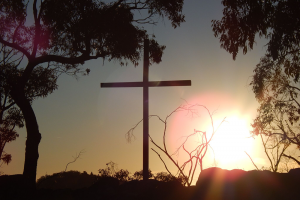 Jesus is raised from the dead! Most of us have experienced times when things have been grim: we have lost a significant other… our treasured hopes have been destroyed… we have been let down, even betrayed… and it seems like the proverbial light at the end of the tunnel is an on-coming train!
Jesus is raised from the dead! Most of us have experienced times when things have been grim: we have lost a significant other… our treasured hopes have been destroyed… we have been let down, even betrayed… and it seems like the proverbial light at the end of the tunnel is an on-coming train!
Generally these painful times pass and life returns to a certain equilibrium – until our next crisis or disaster! This, of course is the pattern, the ebb and flow of human life… ‘death’ and ‘resurrection’.
When we look back and reflect, we can often recognise that something good emerged out of those times of darkness… that we have, in fact, journeyed through a ‘death experience’ to new life! These ‘light-bulb’ moments are gifts: they are ‘Easter’ or ‘Resurrection’ moments… blessings that give us reason to shout, or sing, or say, or perhaps even whisper “Alleluia”!
